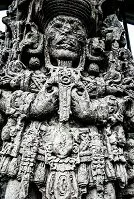Architecture of Honduras
WARNING: Violence is common in Honduras, please read this travel warning before going!

Copan temples
Among the earliest still standing architecture in Honduras is the Mayan city of Copan, which is an impressive stone city. However the Mayan power was centered north of Honduras and the city of Copan was a distant city, whose architecture is impressive, but clearly a peripheral city compared to Tikal and Chichen Itza. There are few other early architectural monuments in Honduras from this time until the arrival of the Spanish in the 1500s.
Despite the lack of historic buildings, the historic styles continued to be built through this time and into the modern age. The indigenous people have various architectural styles and in some parts of the country these styles are quite distinct as each uses different materials, including adobe, mud, clay, or even simple tree branches.
With the arrival of the Spanish a new style arrived as they had a tendency to build churches in the European styles of the time and built houses with either adobe or in a more Mediterranean Spanish style with red tiled roofs. The churches though were more impressive and many are built in the Baroque style, although numerous adaptations were made, most notably in the addition of adobe. The Spanish also changed the urban planning of cities as each was centered around a central square, which generally consisted of a church and government buildings. Today the best of the Spanish colonial architecture can be found in Santa Barbara and Tegucigalpa.